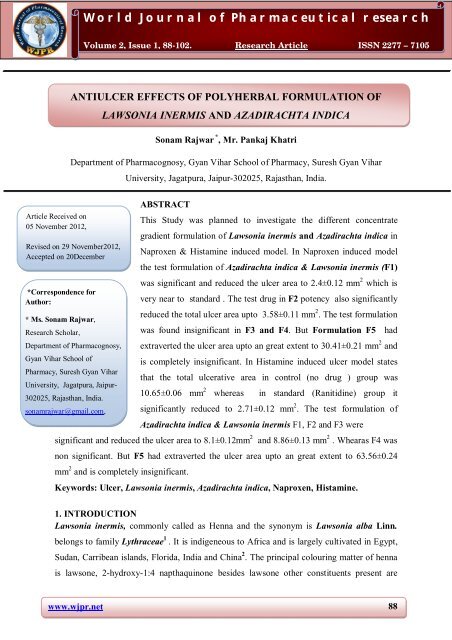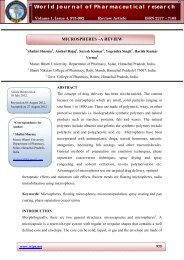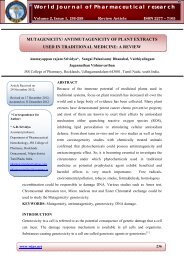World Journal of Pharmaceutical research - WJPR!
World Journal of Pharmaceutical research - WJPR!
World Journal of Pharmaceutical research - WJPR!
You also want an ePaper? Increase the reach of your titles
YUMPU automatically turns print PDFs into web optimized ePapers that Google loves.
Bouchra Meddah et al.<strong>World</strong> <strong>Journal</strong> <strong>of</strong> <strong>Pharmaceutical</strong> ResearchMethod: In this method male wistar rats <strong>of</strong> around 200-230mg were used and grouped intoseven groups, each group consisting <strong>of</strong> 6 animals. Animals were fasted for 24hrs beforetreatment and water was atlibidum. Pretreatment <strong>of</strong> vehicle (distilled water) 1ml/animalp.o.was given to control group. <strong>of</strong> Azadirachta indica & Lawsonia inermis (F1, F2, F3, F4,& F5) were given at the dose <strong>of</strong> 0.5ml/animal p.o to their respective groups <strong>of</strong> animals andOmeprazole (30mg/kg po) was given as the standard drug to treat ulcer 16.After 1 hr Naproxen (30mg/kg po) was given to all groups <strong>of</strong> animals. After 6 hrs Stomach <strong>of</strong>all the animals were isolated, opened along greater curvature, observed under Stereo(Dissecting) microscope & photographs were taken. After that further analysis was done byusing Olympus Image Manager, Adobe Photoshop, Image J 17 .Statistical analysisAll values are expressed as mean ±S.E.M. statistical significance was determined by usingstudent’s t-test values with p
Bouchra Meddah et al.<strong>World</strong> <strong>Journal</strong> <strong>of</strong> <strong>Pharmaceutical</strong> ResearchFigure no 1:- Effect <strong>of</strong> Azadirachta indica & Lawsonia inermis (F1, F2, F3, F4, & F5) in naproxen induced ulcerObservationNaproxen when administered alone or in combination with other agents , induce gastric orduodenal lesions (ulcers or erosions) in various experimental animal. In this studyOmeprazole was used as the standard drug and effects <strong>of</strong> the test drug <strong>of</strong> Azadirachta indica& Lawsonia inermis (F1, F2, F3, F4, & F5) were measured and the following microscopicfindings were observed.a) F1b) F2( I ) ( II )( I ) ( II )www.wjpr.net 94
Bouchra Meddah et al.<strong>World</strong> <strong>Journal</strong> <strong>of</strong> <strong>Pharmaceutical</strong> Researchc) F5( I ) ( II )d) Standard Omeprazole( I ) ( II )e) Control ( No drug )( I ) ( II )Figure no 2:- Microscopic observations <strong>of</strong> naproxen induced ulcerativelesions in rats2.2.2 Histamine induced UlcerAnimalsWistar rats, weighing about 200-230gms were used in experiments. The animals were aquiredfrom animal breeder, Jaipur and kept in polyethene boxes (n=6s), in a controlledwww.wjpr.net 95
Bouchra Meddah et al.<strong>World</strong> <strong>Journal</strong> <strong>of</strong> <strong>Pharmaceutical</strong> Researchenvironment, light dark control each 12 hr. They were kept without food for 12 hrs before theexperiment, and water was adlibidum.The study was approved by C.P.C.S.E. A committee <strong>of</strong>Gyan Vihar School <strong>of</strong> Pharmacy.Experimental ProcedurePrepared extract formulation <strong>of</strong> Azadirachta indica & Lawsonia inermis (F1, F2, F3, F4 &F 5) was orally administered in different regimens as follows1. Group I (F1) : received 0.5ml/animal p.o2. Group II (F2) : received 0.5ml/animal p.o3. Group III (F3) : received 0.5ml/animal p.o4. Group IV (F4) : received 0.5ml/animal p.o5. Group V (F5) : received 0.5ml/animal p.o1hr before the injection <strong>of</strong> ulcer stimulusMethod:- In this method male wistar rats <strong>of</strong> around 200-230mg were used and grouped int<strong>of</strong>ive groups, each group consisting <strong>of</strong> 6 animals. Animals were fasted for 24hrs beforetreatment and water was ad libidum. Pretreatment <strong>of</strong> vehicle (distilled water 1ml/animal p.o.was given to control group. <strong>of</strong> Azadirachta indica & Lawsonia inermis (F1, F2, F3, F4, & F5) were given at the dose <strong>of</strong> 0.5ml/animal p.o to there respective groups <strong>of</strong> animals. AndRanitidine (100mg/kg po) was given as the standard drug to treat ulcer 18 .After 1 hr Histamine (30mg/kg ip) was given to all groups <strong>of</strong> animals. After 6 hrs Stomach <strong>of</strong>all the animals were isolated , opened along greater curvature , observed under Stereo(Dissecting) microscope & photographs were taken. After that further analysis was done byusing Olympus Image Manager, Adobe Photoshop, Image J 19 .Statistical analysis:All values are expressed as mean ±S.E.M. statistical significance was determined by usingstudent’s t-test values with p
Bouchra Meddah et al.<strong>World</strong> <strong>Journal</strong> <strong>of</strong> <strong>Pharmaceutical</strong> ResearchTable No 3 Effect <strong>of</strong> Azadirachta indica & Lawsonia inermis (F1,F2,F3,F4, & F 5) inHistamine induced ulcer.All values are expressed as mean ±S.E.M.; P< 0.01**considered as significant compare tocontrol.Group Dose Total ulcer area(mm 2 )Control 1ml/animal po 17.65±0.06F1 0.5ml/animal p.o 8.1±0.12**F2 0.5ml/animal p.o 8.86±0.13**F3 0.5ml/animal p.o 9.36±0.18**F4 0.5ml/animal p.o 19.23±0.23F5 0.5ml/animal p.o 63.56±0.24Ranitidine 100mg/kg po 2.71±0.12**Figure no 3:- Effect <strong>of</strong> Azadirachta indica & Lawsonia inermis (F1, F2, F3, F4 &F5) in Histamine induced ulcerwww.wjpr.net 97
Bouchra Meddah et al.<strong>World</strong> <strong>Journal</strong> <strong>of</strong> <strong>Pharmaceutical</strong> ResearchObservationsHistamine when administered alone or in combination with other agents, induce gastric orduodenal lesions ( ulcers or erosions ) in various experimental animals. In this studyRanitidine was used as the standard drug and effect <strong>of</strong> Azadirachta indica & Lawsoniainermis (F1, F2, F3, F4, & F5)following microscopic findings were observed.a) F1in histamine induced ulcer were measured and theb) F2( I ) ( II )( I ) ( II )c) F5( I ) ( II)www.wjpr.net 98
Bouchra Meddah et al.<strong>World</strong> <strong>Journal</strong> <strong>of</strong> <strong>Pharmaceutical</strong> Researchd) Control( I ) ( II )e) Standard Ranitidine( I ) ( II )Figure no 4:- Microscopic observations <strong>of</strong> histamine induced ulcerative lesionsin rats3. RESULTSThe microscopic findings in Naproxen induced ulcer model states that the total ulcerativearea in control (no drug) group was 7.51±0.05 mm 2 whereas in standard (omeparazole) groupit significantly reduced to 2.33±0.05 mm 2 . The test formulation <strong>of</strong> Azadirachta indica &Lawsonia inermis (F1) was significant and reduced the ulcer area to 2.4±0.12 mm 2 which isvery near to standard . The test drug in F2 potency also significantly reduced the total ulcerarea upto 3.58±0.11 mm 2 . The test formulation was found insignificant in F3 and F4. ButFormulation F5 had extraverted the ulcer area upto an great extent to 30.41±0.21 mm 2 andis completely insignificant. The microscopic findings in Histamine induced ulcer model statesthat the total ulcerative area in control (no drug ) group was 10.65±0.06 mm 2 whereas instandard (Ranitidine) group it significantly reduced to 2.71±0.12 mm 2 . The test formulation<strong>of</strong> Azadirachta indica & Lawsonia inermis F1, F2 and F3 were significant and reduced theulcer area to 8.1±0.12mm 2 and 8.86±0.13 mm 2 . Whearas F4 was non significant. But F5 hadwww.wjpr.net 99
Bouchra Meddah et al.<strong>World</strong> <strong>Journal</strong> <strong>of</strong> <strong>Pharmaceutical</strong> Researchextraverted the ulcer area upto an great extent to 63.56±0.24 mm 2 and is completelyinsignificant.4. DISCUSSIONThe mechanism by which the Naproxen induce gastric lesions is likely due to prostaglandin(PGE2) secreation inhibition which leads to mucosal layer inhibition and forms ulcer.Development <strong>of</strong> such gastric lesions can be inhibited antiulcer drugs which increaseprostaglandin (PGE 2) secreation and thus forms mucosal layer to prevent ulcer 20,21 . Theresults concluded that formulation <strong>of</strong> Azadirachta indica & Lawsonia inermis F1 and F2 arehaving the comparable effect with the standard Omeprazole and can be predicted that theseformulations may have PGE2 enhancing activity and thus are good antiulcer agents. WhereasF5 <strong>of</strong> formulation effect extraverts’ ulcer up to an large extent in experimental animals.The mechanism by which the histamine induce gastric lesions is likely due to its potent acidstimulating and or vasodilating capability, which leads to increased vascular permeability.Development <strong>of</strong> such gastric lesions was inhibited by histamine H 2 receptor antagonists. Theresults concluded that homeopathic formulation Azadirachta indica & Lawsonia inermis F1and F2 are not having significant effect with the standard ranitidine and can be predicted thatthese formulations do have H 2 receptor antagonist activity and thus are not good antiulceragents. Whereas F5 <strong>of</strong> formulation effect extraverts’ ulcer up to an large extent inexperimental animals 22,23 .5. CONCLUSIONIt is clear that the medicinal plants play a vital role against on various diseases. Variousherbal plants and plants extracts have significant antiulcer activity in animal models. Theresults obtained from the present study show that the Polyherbal Formulation <strong>of</strong> Lawsoniainermis and Azadirachta indica had beneficial Antiulcer effects in Naproxen & Histamineinduced models. The results <strong>of</strong> this study indicate that extracts <strong>of</strong> leaves <strong>of</strong> Lawsonia inermisand Azadirachta indica appears to be useful material for further studies, leading to possibledrug development for Ulcer as their combined formulation on different concentrationgradient had shown the potential role <strong>of</strong> antiulcer activity have good potentials for use inpeptic ulcer disease. Further Phytochemical investigations are required to elucidate the exactmechanism <strong>of</strong> action & also the active principles responsible for such effects.www.wjpr.net 100
Bouchra Meddah et al.<strong>World</strong> <strong>Journal</strong> <strong>of</strong> <strong>Pharmaceutical</strong> Research6. ACKNOWLEDGEMENTAuthors are thankful to Chairman, Chief mentor, Vice Chancellor <strong>of</strong> Suresh Gyan ViharUniversity, Jagatpura, Jaipur, Rajasthan for necessary facilities.7. REFERENCES1. M Grieve, www.botanical.com/botanical/mgmh /h/henna-24.html (April11,2005).2. Kokate C.K, Porohit A.P, Gokhale S.B; Pharmacognosy; Nirali Prakashan, 37 edition;Page No. 254.3.Gagandeep Chaudhary, Sandeep Goyal, Priyanka Poonia; Lawsonia inermis Linnaeus: APhytopharmacological Review International <strong>Journal</strong> <strong>of</strong> <strong>Pharmaceutical</strong> Sciences and DrugResearch 2010; 2(2): 91-98 ISSN 0975-248X.4. Rosenberg, N.M: Antibacterial deodorizing compositions containing extracts <strong>of</strong> Lawsoniaalba. PCT, 1999; 37.5. Ahmed S, Rahman A, Alam A, Saleem M, Athar M and Sultana S: Evaluation <strong>of</strong> theefficacy <strong>of</strong> lawsonia alba in the alleviation <strong>of</strong> carbon tertrachloride-induced oxidativestress. J Ethnopharm, 2000; 69: 157-164.6. Kausik Biswas, Ishita Chattopadhyay, Ranajit K. Banerjee and Uday Bandyopadhyay;Biological activities and medicinal properties <strong>of</strong> neem (Azadirachta indica); CurrentScience, Vol. 82, No. 11, 10 June 2002; 1336-1345.7. Zoheir.Y.Ashrafi, Sedigheh Sadeghi, Hassan.M.Alizade, Hamid.R.Mashhadi, Ebrahim. R.Mohamadi; Study <strong>of</strong> Bioassay the Allelopathical Effect <strong>of</strong> Neem (Azadirachta indica) n-hexane, Acetone and Water-soluble Extracts on Six Weeds; International <strong>Journal</strong> <strong>of</strong>Biology; Vol. 1 No.1 2009; 71.8. I.P Ogbuewu, V.U Odoemenam, H.O. Obikaonu, M.N. Opara, O.O Emenalom, M.C.Uchegbu, I.C. Okali, B.O, Esonu & M.U. Iloeje; The Growing Importance <strong>of</strong> Neem(Azadirachta indica A. Juss) in Agriculture, Industry, Medicine & Environment;Research <strong>Journal</strong> <strong>of</strong> Medicinal Plant (3): 230-245, 2011.9. Sravani P, Jayasri P, Samiulla, Ershad Khan P, Nishad Khan P; “Review on NaturalAntiulcer agents”; Int. J. Pharm & Ind. Res Vol – 01 Issue – 01, 2011, Page no: 67-70.10. R.Ramasubramaniaraja et al., “Peptic Ulcer and Phytochemistry : An Overview”; <strong>Journal</strong><strong>of</strong> Pharmacy Research 2011,4(1),156-160.11.Tripathi KD; Essential <strong>of</strong> Medical Pharmacology; Fifth edition; Jaypee Brothers MedicalPublishers (P) LTD, Page No: 588-589.www.wjpr.net 101
Bouchra Meddah et al.<strong>World</strong> <strong>Journal</strong> <strong>of</strong> <strong>Pharmaceutical</strong> Research12.Syamsudin, Inawati, and Hendig Winarno; The effect <strong>of</strong> Inai (Lawsonia inermis Linn)leaves extract on Blood Sugar level: An experimental Study; Research <strong>Journal</strong> <strong>of</strong>Pharmacology 2(2): 20-23, 2008 ISSN: 1815-1962.13.Gagandeep Chaudhary, Sandeep Goyal1, Priyanka Poonia Lawsonia inermis Linnaeus: APhytopharmacological Review International <strong>Journal</strong> <strong>of</strong> <strong>Pharmaceutical</strong> Sciences and DrugResearch 2010; 2(2): 91-98 ISSN 0975-248X.14.Akinola et al. ; Intestinal Lesions <strong>of</strong> Streptozocin-induced Diabetes and the effects <strong>of</strong>Azadirachta indica Treatment; Pharmacologyonline 3: 872-881 (2009).15.Shradha Bisht, S.S.Sisodia; Anti-Hyperglycemic And Antidyslipidemic Potential OfAzadirachta indica Leaf Extract In STZ- Induced Diabetes Mellitus; J. Pharm. Sci. &Res. Vol.2 (10), 2010,622-627.16.Satoh H, Guth PH, and Grossman MI; Role <strong>of</strong> food in gastrointestinal ulceration producedby food in rat , <strong>Journal</strong> <strong>of</strong> Gastroenterology.;83; 1982; 210-215.17.Kalies I; Li H and Mellgard B . A rat model <strong>of</strong> chronic Helicobacter pylori infection .Studies <strong>of</strong> epithelial cell turnover and gastric ulcer healing. <strong>Journal</strong> <strong>of</strong>Gastroentrology.;33; 1998;370-378.18.Kikuko.A.and Susume .O. ; Histamine induction <strong>of</strong> gastric mucosal lesions in rats; <strong>Journal</strong><strong>of</strong> pharmacology Sciences . 92; 2003; 124-136.19.Warzwcha Z and Dembinski A; <strong>Journal</strong> <strong>of</strong> physiology and pharmacology;52;2001; 407-421.20. Jeong-Hwan Kim. Protective effect <strong>of</strong> astaxanthin on naproxen-induced gastric antralulceration in rats. European <strong>Journal</strong> <strong>of</strong> Pharmacology ; 514; 2005; 53 – 59.21.Hyae gyeong cheon ; Ant– ulcer activity <strong>of</strong> SKP 450 , A novel potassium channelactivator in rats. Pharmacological Research, 40, (30); 199;65-69.22. Jain S.M. Parmar N.S and Santani D.D. Gastric antiulcer activity <strong>of</strong> calcium channelblocker in rats; Indian <strong>Journal</strong> <strong>of</strong> Pharmacology; 26; 1994; 29 – 34.23. Ping Jiang, Lin Chang, Chun-Shui Pan, Yong-Fen Qi, and Chao-Shu Tang ; Protectiverole <strong>of</strong> metallothionein in stress-induced gastric ulcer in rats, <strong>World</strong> <strong>Journal</strong> <strong>of</strong>Gastroenterology;11(18); 2005;739-743.www.wjpr.net 102









